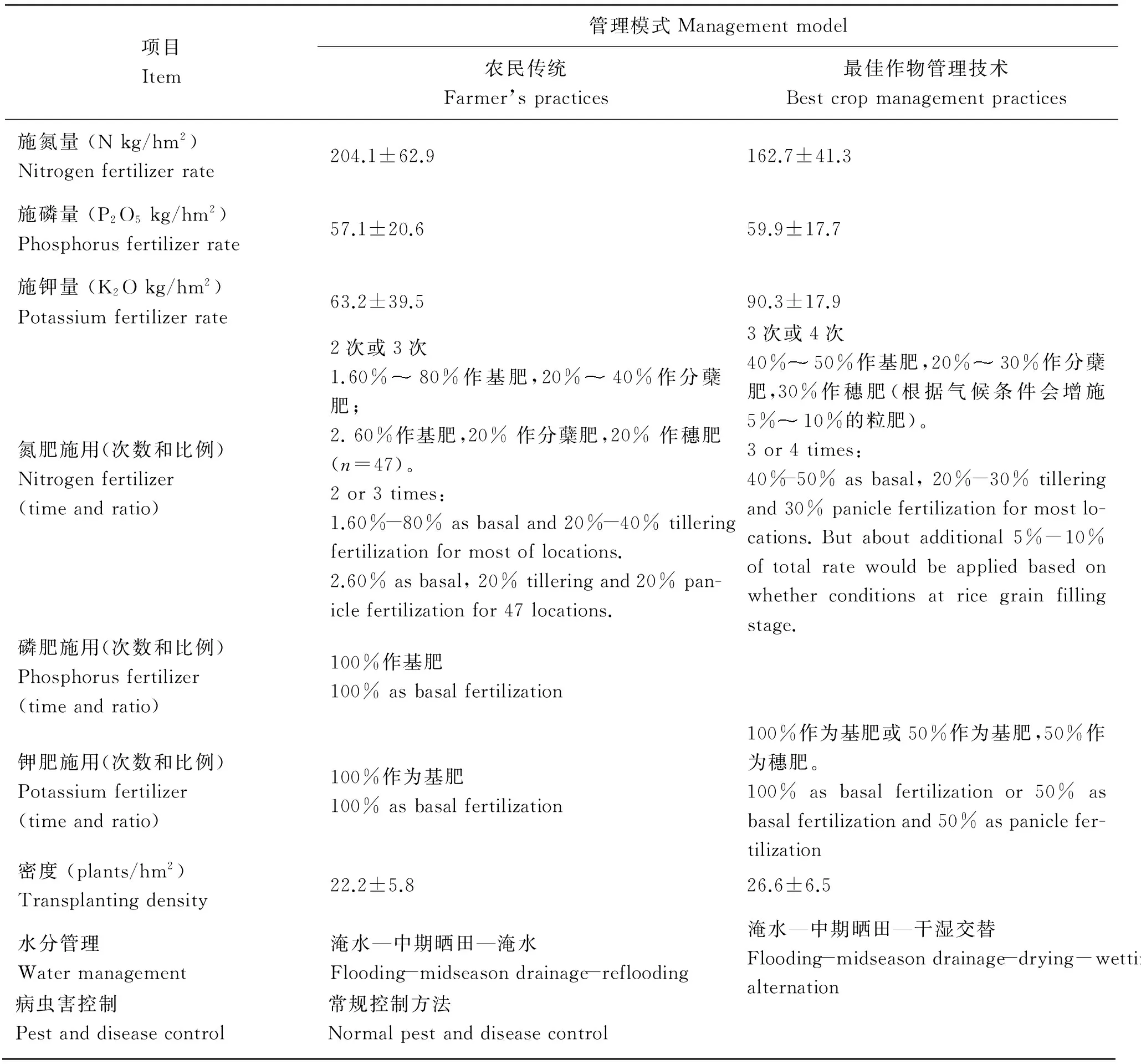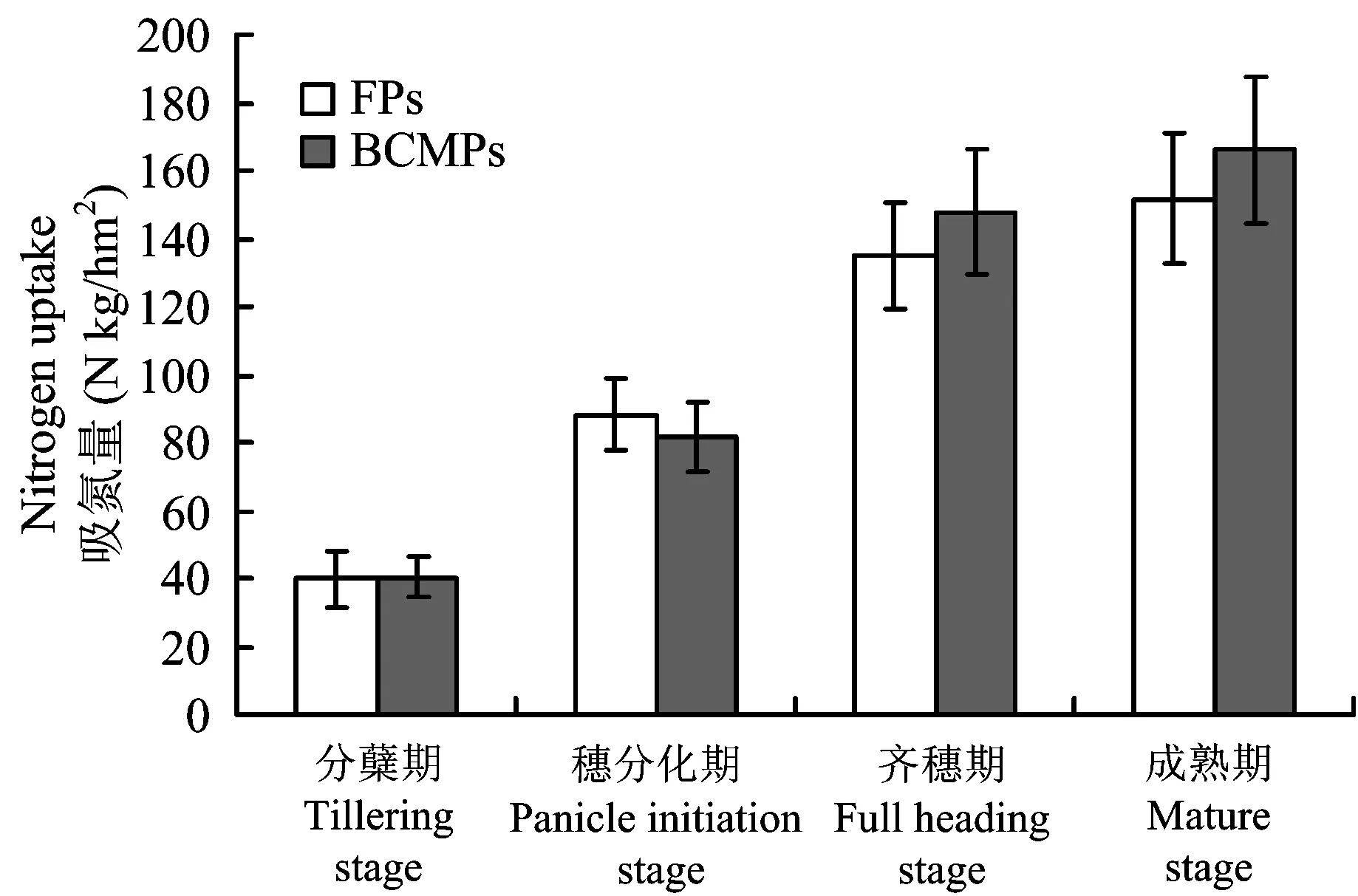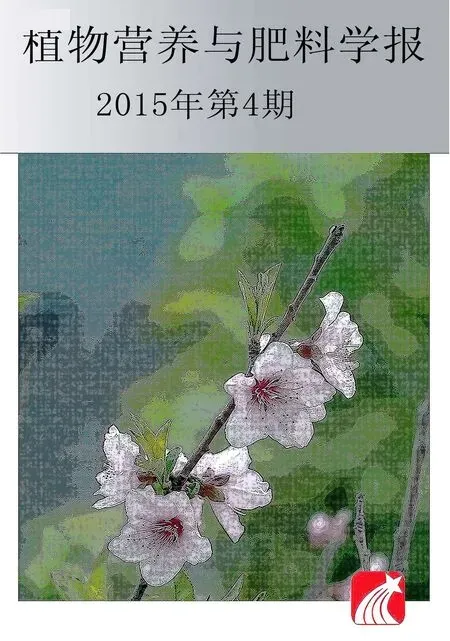水稻最佳作物管理技术的增产增效作用
2015-06-12范明生张福锁
安 宁, 范明生, 张福锁
(中国农业大学资源与环境学院,北京 100193)
水稻最佳作物管理技术的增产增效作用
安 宁, 范明生*, 张福锁
(中国农业大学资源与环境学院,北京 100193)

最佳作物管理技术; 产量; 氮肥利用率; 干物质积累; 产量构成

随着我国人口的不断增长,对稻谷的需求也日益增加。按照目前我国稻米的年消费量预测, 到2030年我国的水稻需求量需增加30%以上[16]。为了满足未来水稻生产需求,必须通过在现有甚至减少的种植面积的条件下大幅度提高单产,同时应提高养分资源,尤其是氮肥的利用效率,从而减少对环境的影响[3]。目前我国水稻产量徘徊不前的主要原因可能是: 1)农民传统生产方式下的水稻平均产量已经达到可实现产量的70%以上[17],进一步提高产量需要更加精细的管理技术,但这往往在经济和实践中的可行性低; 2)目前农户不合理的管理措施仍然是增产和增效的限制因子,如水稻栽插密度低、 水分管理不合理 (大多数农民采用淹水—中期烤田—淹水的灌溉方式)、 养分管理不合理等,如氮肥投入量过大,农民一般分两次施用(基肥和蘖肥)且基肥施用多,这样会造成更大的氮的损失,同时不能满足高产水稻的需求。而最近的研究表明,水稻的吸氮高峰期出现在幼穗分化期,而在水稻生长后期光照更加充足的年份,增加粒肥能促进籽粒灌浆和增产,因此,增加中后期的施用比例(穗肥和粒肥)是水稻高产和氮肥高效利用的基础[18-20]。
本研究在我国水稻主产区403个农民田块的试验示范基础上,利用试验示范数据,比较了最佳作物管理技术和农民传统方式两种管理模式下的水稻产量、施氮量、氮肥利用率以及生长动态 (作物吸氮量和干物质积累) 的差异,在现有品种条件下,针对水稻生产的主要限制因子,通过管理技术的优化,明确增产与增效的实现程度,旨在为我国水稻生产实践提供理论与技术支撑。
1 材料与方法
1.1 试验设计


表1 田间试验中农民传统处理和最佳作物管理技术处理的管理信息Table 1 Detailed information in management for farmer’s practices and best crop management practices in 403 on-farm trials
1.2 测定项目与方法

1.2.2 水稻吸氮量和干物质积累量 在12个试验点(其中包括南方双季早稻、双季晚稻和单季稻),分别于分蘖期、穗分化期、抽穗期和成熟期取植株样品。每个点在各地块取 0.5 m2的植株样,于105℃烘箱杀青30 min,80℃烘72 h后称重,并折算成每公顷干重。样品经粉碎过筛,采用H2S04-H202消化,以半微量凯氏定氮法测定植株氮含量。
1.3 计算方法和数据处理
氮肥利用率的计算公式为[23]:
氮肥偏生产力 (PFP,kg/kg) =施氮小区水稻籽粒产量(kg/hm2)/施氮量(N kg/hm2)
氮肥农学利用率 (AE,kg/kg) =[施氮小区水稻籽粒产量(kg/hm2)-空白小区水稻籽粒产量(kg/hm2)]/施氮量(N kg/hm2)
氮肥回收利用率 (RE,%)=[施氮小区水稻吸氮量(N kg/hm2)-空白小区水稻吸氮量(N kg/hm2)]/施氮量(N kg/hm2) ×100
试验数据采用EXCEL、SPSS软件进行处理与分析。
2 结果与分析
2.1 施氮量、产量和氮肥利用率
表2显示,最佳作物管理技术表现出良好的减氮、增产和增效潜力。农民传统处理的平均施氮量为204.1 kg/hm2,最佳作物管理技术处理氮肥用量减少了20.3%;氮肥的减少并没有使水稻的产量下降,反而表现出较大的增产效应。农民传统处理的平均产量为7226.4 kg/hm2,最佳作物管理技术处理的平均产量为7917.0 kg/hm2,增长率为9.6%;由于氮肥施用量的减少和产量的增加,最佳作物管理技术处理的氮肥利用率大幅度增加,显著高于农民传统处理,农民传统处理和最佳作物管理技术处理的氮肥偏生产力(PFP)、农学利用率(AE)和氮肥回收率(RE)分别为37.3 kg/kg和50.8 kg/kg,8.5 kg/kg和14.9 kg/kg,28.7%和42.3%,增长率分别为36.2%、75.3%和13.6个百分点,AE的增长幅度最大,其次为PFP和RE。

表2 农民传统处理和最佳作物管理技术处理的施氮量、产量、氮肥效率和减氮、增产、增效的百分比Table 2 N rate, yield, nitrogen use efficiency under farmer’s practices(FPs) and best crop management practices(BCMPs)
注(Note): FPs—Farmer’s practices; BCMPs—Best crop management practices; PFP—Partial factor productivity; AE—Agronomic efficiency; RE—Recovery efficiency. 同列数据后不同字母表示处理间差异达5%显著水平 Values followed by different letters in a column are significantly different among treatments at the 5% level.
2.2 水稻的氮素吸收动态
农民传统和最佳作物管理技术处理的氮素吸收在水稻整个生长期表现出相似的规律,齐穗期之前氮素迅速累积,到齐穗期之后氮素的吸收速率下降,但具体在各个时期的累积吸氮量和阶段吸氮量不同,从图1可以看出,农民传统和最佳作物管理技术处理的累积吸氮量,在分蘖期分别为39.8 kg/hm2和40.2 kg/hm2,占作物收获期吸氮量的26.2%和24.2%;在穗分化期分别为88.2 kg/hm2和81.6 kg/hm2,占作物收获期吸氮量的58.1%和49.2%;在齐穗期分别为134.9 kg/hm2和147.7 kg/hm2,占作物收获期吸氮量的88.9%和89.0%;在成熟期分别为151.7 kg/hm2和165.9 kg/hm2。两种管理措施下,水稻的阶段氮素吸收量也存在差异:从分蘖期到穗分化期,农民传统和最佳作物管理技术处理的阶段吸氮量分别为48.4 kg/hm2和41.4 kg/hm2,占作物收获期吸氮量的31.9%和24.9%;穗分化期到齐穗期,阶段吸氮量分别为46.7 kg/hm2和66.1 kg/hm2,占作物收获期吸氮量的30.8%和39.8%;齐穗期到成熟期,阶段吸氮量分别为16.8 kg/hm2和18.2 kg/hm2,占作物收获期吸氮量的11.1%和11.0%。农民传统处理在生育前期表现出较大的氮吸收能力,但从齐穗期开始,最佳作物管理技术处理的氮吸收能力要大于农民传统处理。由于试验点分布在不同的水稻种植地区,土壤供氮能力不同,不同地区的水稻累积吸氮量和阶段吸氮量也有一定差异,虽然没有达到差异显著水平,但总体趋势明显。

图1 农民传统处理(FPs)和最佳作物管理技术 处理(BCMPs)水稻不同生育期的吸氮量Fig.1 Nitrogen uptake of farmer’s practices (FPs) and best crop management practices (BCMPs) at different rice growth stages
2.3 水稻的干物质累积动态
农民传统和最佳作物管理技术处理水稻的干物质累积与氮素吸收的趋势类似。穗分化期之前干物质累积相对缓慢,到穗分化期之后干物质的积累开始迅速上升,但在各个时期的干物质积累的绝对值不同。图2显示,农民传统和最佳作物管理技术处理的干物质累积量,在分蘖期分别为1399.9 kg/hm2和1524.0 kg/hm2,占作物收获期干物质累积量的10.8%和11.0%;在穗分化期分别为3875.0 kg/hm2和3856.4 kg/hm2,占作物收获期干物质累积量的30.0%和28.0%;在齐穗期分别为8869.0 kg/hm2和9141.6 kg/hm2,占作物收获期干物质累积量的68.7%和66.3%;成熟期时别为12914.2 kg/hm2和13796.1 kg/hm2,在收获期,干物质的累积量表现出显著差异 (P<0.05)。同时,农民传统和最佳作物管理技术处理的花后干物质积累量分别为4045.2 kg/hm2和4654.5 kg/hm2,二者差异显著(P<0.05)。

图2 农民传统处理(FPs)和最佳作物管理技术处理 (BCMPs) 水稻不同生育期干物质累积量Fig.2 Dry matter accumulation of farmer’s practices (FPs) and best crop management practices (BCMPs) at different rice growth stages
2.4 产量构成
不同管理措施对水稻的产量构成因素有明显影响,从表3可以看出,最佳作物管理技术处理的每平方米平均穗数为243.2,显著大于农民传统处理的231.7 (P<0.05);最佳作物管理技术处理的平均穗粒数为154.2,显著大于农民传统处理的150.0 (P<0.05);同时,最佳作物管理技术处理的平均千粒重为26.9 g,显著大于农民传统处理的26.6 g (P<0.05)。

表3 农民传统处理和最佳作物管理技术处理的产量构成Table 3 Yield components of farmer’s practices (FPs) and best crop management practices (BCMPs)
注(Note): 同列数据后不同字母表示处理间差异达5%显著水平 Values followed by different letters in a column are significantly different among treatments at the 5% level.
3 讨论与结论
尽管我国水稻种植历史悠久,种植技术相对成熟,农民的水稻平均产量达到可实现产量的70%以上[17],但是,不合理的水肥以及作物管理仍然是水稻高产高效的限制因子。目前的研究表明,我国的水稻仍然能够通过优化水肥以及作物管理技术实现增产10%,增产的原因可能是:1)氮肥施用量和时期匹配高产水稻的生理需求,减少早衰,促进干物质累积,尤其是后期干物质的累积,促进了氮素吸收和千粒重的增加[18, 24-25]。增加生物产量是获得高产的物质基础,且经济产量主要决定于齐穗后群体的光合生产量,即花后期的干物质积累量[26-27]。在本研究条件下,最佳作物管理技术的水稻花后干物质积累量为4655 kg/hm2,占总干物质积累的34%; 2)增加钾肥的施用,尤其是增加抽穗期钾肥的施用,这可能增加水稻根系的活力,促进对养分的吸收,有利于形成高产群体[28-29]; 3)个别点(n=43)施用硅肥或微量元素,可能也有一定的增产效果;4)增加栽插密度,保障了合理的群体数量和穗数;5)后期的干湿交替灌溉,促进了弱势粒灌浆,增加每穗粒数[30]。同时,本研究也表明,最佳作物管理技术可以实现在增产的基础上同时减少氮肥施用量,即与农民传统的管理方式相比,氮肥用量节省20%,氮肥偏生产力、农学利用率和氮肥回收利用率分别增加36.2%、75%和13.6个百分点。由此可见,我国的水稻生产系统有更大的节氮和增效的潜力。

[1] Frolking S, Qiu J J, Boles Setal. Combining remote sensing and ground census data to develop new maps of the distribution of rice agriculture in China[J]. Global Biogeochemical Cycles, 2002, 16: 1091-1101.
[2] FAO. http://faostat.fao.org. 2010.
[3] Fan M S, Shen J B, Yuan L Xetal. Improving crop productivity and resource use efficiency to ensure food security and environmental quality in China[J]. Journal of Experimental Botany, 2012, 63(1): 13-24.
[4] Heffer P. Assessment of fertilizer use by crop at the global level: 2006/07-2007/08[R]. Pairs, France: International Fertilizer Industry Association, 2009.
[5] Roelcke M, Han Y, Schleef K Hetal. Recent trends and recommendations for nitrogen fertilization in intensive agriculture in eastern China[J]. Pedosphere, 2004, 14: 449-460.
[6] Peng S B, Buresh R J, Huang J Letal. Improving nitrogen fertilization in rice by site-specific N management. A review[J]. Agronomy for Sustainable Development, 2010, 30: 649-656.
[7] 彭少兵, 黄见良, 钟旭华, 等. 提高中国稻田氮肥利用率的研究策略[J]. 中国农业科学, 2002, 35(9): 1095-1103. Peng S B, Huang J L, Zhong X Hetal. Research strategy in improving fertilizer nitrogen use efficiency of irrigated rice in China[J]. Scientia Agricultura Sinica, 2002, 35(9): 1095-1103.
[8] 林葆. 提高作物产量, 增加施肥效应[A]. 中国土壤学会. 中国土壤科学的现状与前景[M]. 江苏: 江苏科学技术出版社,1991. 29-36. Lin B. Make the most efficient use of fertilizers in increasing crop production [A]. Soil science society of China. Soil Science in China. Present and future[M]. Jiangsu: Jiangsu Science and Technology Press, 1991. 29-36.
[9] 李庆逵. 中国农业持续发展中的肥料问题[M]. 南昌: 江西科学技术出版社, 1997. Li Q K. Fertilizer issues in the sustainable development of China agriculture[M]. Nanchang: Jiangxi Science and Technology Press, 1997.
[10] Cassman K G, Gines H C, Dizon M Aetal. Nitrogen-use efficiency in tropical lowland rice systems: contributions from indigenous and applied nitrogen[J]. Field Crops Research, 1996, 47: 1-12.
[11] Cassman K G, Dobermann A R, Walters D T. Agroecosystems, nitrogen-use efficiency, and nitrogen management[J]. AMBIO: A Journal of the Human Environment, 2002, 3(2): 132-140.
[12] Vitousek P M, Aber J D, Howarth R Wetal. Human alteration of the global nitrogen cycle: sources and consequences[J]. Ecological Application, 1997, 7: 737-750.
[13] Zhu Z L, Xiong Z Q, Xing G X. Impacts of population growth and economic development on the nitrogen cycle in Asia[J]. Science in China (Series C: Life Science), 2005, 48: 729-737.
[14] Guo J H, Liu X J, Zhang Yetal. Significant acidification in major Chinese croplands[J]. Science, 2010, 327: 1008-1010.
[15] Zheng X H, Han S H, Huang Yetal. Re-quantifying the emission factors based on field measurements and estimating the direct N2O emission from Chinese croplands[J]. Global Biogeochemical Cycles, 2004, 18: GB2018, doi: 10.1029/2003GB002167.
[16] Shen J B, Cui Z L, Miao Y Xetal. Transforming agriculture in China: From solely high yield to both high yield and high resource use efficiency[J]. Global Food Security, 2013, 2(1): 1-8.
[17] Wart J V, Christian Kersebaum K, Peng S Betal. Estimating crop yield potential at regional to national scales[J]. Field Crops Research, 2013, 143: 34-43.
[18] Fan M S, Lü S H, Jiang R Fetal. Triangular transplanting pattern and split nitrogen fertilizer application increase rice yield and nitrogen fertilizer recovery[J]. Agronomy Journal, 2009, 101(6): 1421-1425.
[19] 张福锁, 范明生. 主要粮食作物高产栽培与资源高效利用的基础研究[M]. 北京: 中国农业出版社, 2013. 199-204. Zhang F S, Fan M S. The basic research of high yield and high resources use efficiency of the main food crops[M]. Beijing: China Agriculture Press, 2013. 199-204.
[20] 申建波, 张福锁. 水稻养分资源综合管理理论与实践[M]. 北京: 中国农业出版社, 2006. 37-43. Shen J B, Zhang F S. Theory and practice of rice nutrient integrated management[M]. Beijing: China Agriculture Press, 2006. 37-43.
[21] Zhang H, Chen T T, Wang Z Qetal. Involvement of cytokinins in the grain filling of rice under alternate wetting and drying irrigation[J]. Journal of Experimental Botany, 2010, 61: 3719-3733.
[22] Doberman A, Fairhurst T H. Rice: Nutrient disorders and nutrient management[M]. Singapore: Potash and Phosphate Institute, and Manila, IRRI, 2000.
[23] Cassman K G, Peng S B, Olk D Cetal. Opportunities for increased nitrogen-use efficiency from improved resource management in irrigated rice systems[J]. Field Crops Research, 1998, 56: 7-39.
[24] 肖恕贤, 覃步生, 陈盛球. 等. 杂交早稻需肥特性和施肥技术研究[J]. 作物学报, 1982, 8(1): 23-32. Xiao S X, Qin B S, Chen S Qetal. Studies on the characteristics of fertilizer requirement of hybrid rice and the application technique[J]. Acta Agronomica Sinica, 1982, 8(1): 23-32.
[25] 石庆华, 潘晓华, 钟旭华. 等. 杂交早稻的吸氮特性与产量形成的初步研究[J]. 江西农业大学学报, 1989, 11(l): 18-24. Shi Q H, Pan X H, Zhong X Hetal. Studies on the characteristics of nitrogen absorption and the yield formation in early hybrid rice[J]. Acta Agriculturae Universitatis Jiangxiensis, 1989, 11(l): 18-24.
[26] 陈温福, 徐正进, 张文忠, 等. 水稻新株型创造与超高产育种[J]. 作物学报, 2001, 27(5): 665-672. Chen W F, Xu Z J, Zhang W Zetal. Creation of new plant type and breeding rice for super high yield[J]. Acta Agronomica Sinica, 2001, 27(5): 665-672.
[27] 凌启鸿. 作物群体质量[M]. 上海: 上海科学技术出版社, 2001. 16-42. Lin Q H. Crop population quality[M]. Shanghai: Shanghai Scientific and Technical Publishers, 2001. 16-42.
[28] 何电源, 吕龙石, 李桂花, 等. 中国南方土壤肥力与栽培植物施肥[M]. 北京: 科学出版社, 1994. He D Y, Lü L S, Li G Hetal. Soil fertility and fertilization of cultivated plant in South China[M]. Beijing: Science Press, 1994.
[29] 胡泓, 王光火. 钾肥对杂交水稻养分积累以及生理效率的影响[J]. 植物营养与肥料学报, 2003, 9(2): 184-189. Hu H, Wang G H. Influence of potassium fertilizer on nutrient accumulation and physiological efficiency of hybrid rice[J]. Plant Nutrition and Fertilizer Science, 2003, 9(2): 184-189.
[30] 杨建昌.水稻弱势粒灌浆机理与调控途径[J]. 作物学报, 2010, 36(12): 2011-2019. Yang J C. Mechanism and regulation in the filling of inferior spikelets of rice[J]. Acta Agronomica Sinica, 2010, 36(12): 2011-2019.
[31] 吴良泉, 蔡国学, 石孝均, 等. 水稻配方肥与机插秧集成技术应用效果研究[J]. 中国农技推广, 2013, 29 (1): 35-36. Wu L Q, Cai G X, Shi X Jetal. The agronomical effects of formulated fertilizer and mechanical transplanting of rice[J]. China Agricultural Technology Extension, 2013, 29 (1): 35-36.
[32] Zhang F S, Fan M S, Zhao B Qetal. Fertilizer use, soil fertility and integrated nutrient management in China [A]. Zhang F S, Fan M S. Improving plant nutrient management for better farmer livelihoods[C]. Beijing: Food Security and Environmental Sustainability Proceeding of a Regional Workshop, 2005.
[33] 许迪, 康绍忠. 现代节水农业技术研究进展与发展趋势[J]. 高技术通讯, 2002, 12: 103-108. Xu D, Kang S Z. Research progress and development trend on modernized agriculture water-saving technology[J]. High Technology Letters, 2002, 12: 103-108.
[34] Zou J W, Huang Y, Qin Y Metal. Changes in fertilizer-induced direct N2O emissions from paddy fields during rice-growing season in China between 1950s and 1990s[J]. Global Change Biology, 2009, 15: 229-242.
[35] 石生伟, 李玉娥, 刘运通, 等. 中国稻田CH4和N2O排放及减排整合分析[J]. 中国农业科学, 2010, 43(14): 2923-2936. Shi S W, Li Y E, Liu Y Tetal. CH4and N2O emission from rice field and mitigation options based on field measurements in China: An integration analysis[J]. Scientia Agricultura Sinica, 2010, 43(14): 2923-2936.
[36] Fan M S, Lal R, Cao Jetal. Plant-based assessment of soil productivity and contributions to China’s cereal crop yield increase since 1980[J]. Plos One, 2013, 8 (9): e74617. doi: 10.1371/journal.pone.0074617.
Best crop management practices increase rice yield and nitrogen use efficiency
AN Ning, FAN Ming-sheng*, ZHANG Fu-suo
(CollegeofResourcesandEnvironmentalScience,ChinaAgriculturalUniversity,Beijing100193,China)
【Objectives】Rice is one of the main staple crops in China. In order to meet the increasing demand of rice production for growing population with even reduced rice cultivation area, rice farming systems must be managed to achieve the goal of high rice productivity and primary resources (e.g. nitrogen and water) use efficiency while without further degradating environmental integrity. 【Methods】 Based on 403 on-farm trails conducted in China’s major rice producing provinces (Including Hunan, Hubei, Guangdong, Anhui, Jiangsu and the Great Chongqing Area) from 2008 to 2011, nitrogen application rate, rice yield, nitrogen use efficiency (partial factor productivity, agronomic efficiency and recovery efficiency), nitrogen uptake and dry matter accumulation dynamics of rice plant during the main period of rice growth (tillering stage, panicle initiation stage, full heading stage and mature stage) were compared between treatments of conventional farmers’ practices (FPs) and the best crop management practices (BCMPs). The main technology of best crop management practices was optimum nitrogen management with side dressing while control the total amount of application, customized application rate of phosphorus and potassium by monitoring available phosphorus and potassium in the soil, increased transplanting density and optimized water management through controled dry and irrigation cycles after midseason drainage. 【Results】 Compared with FPs, the yield of BCMPs was 7917.0 kg/hm2and increased significantly by 690.6 kg/hm2(9.6%) (P<0.05) while nitrogen fertilizer application was significantly reduced by N 41.4 kg/hm2(20.3%) (P<0.05). The nitrogen partial factor productivity, agronomic efficiency and recovery efficiency of BCMPs were significantly higher than those of FPs by 36.2%, 75.3% and 13.6 percentage points,respectively (P<0.05). Nitrogen uptake and dry matter accumulation of rice plant under FPs were greater than those of BCMPs during earlier stage. After full heading stage, nitrogen uptake and dry matter accumulation of rice plant under treatment of BCMPs were greater than those of FPs. During mature stage, the nitrogen uptake of rice plant under treatment of FPs and BCMPs were 151.7 kg/hm2and 165.9 kg/hm2, and dry matter accumulation were 12914.2 kg/hm2and 13796.1 kg/hm2, respectively (P<0.05). The dry matter accumulation after flowering was significantly different between FPs and BCMPs, which was 4045.2 kg/hm2and 4654.5 kg/hm2, respectively (P<0.05). Panicles number per square meter, spikelet number per panicle and 1000-grain weight of BCMPs were 243.2, 154.2 and 26.9 g respectively, which were significantly greater than those of FPs (P<0.05). 【Conclusions】 Improved crop management practices as BCMPs could increase yield by 9.6% while reduce nitrogen and water use. These best crop management techniques are convenient and easily adopted practices that may be applied widely in rice cropping systems. This study provides the guide for sustainable rice-based cropping systems.
best crop management practices;yield;nitrogen use efficiency;dry matter accumulation;yield components
2014-04-13 接受日期: 2014-06-04 网络出版日期: 2015-05-06
农业部公益型行业专项 “最佳养分管理技术”项目(201103003)资助。
安宁(1985—),女,内蒙古巴彦淖尔市人,博士研究生,主要从事养分资源管理方面的研究工作。E-mail: anning1011@163.com * 通信作者 Tel: 010-62731661, E-mail: fanms@cau.edu.cn
S511.06
A
1008-505X(2015)04-0846-07
